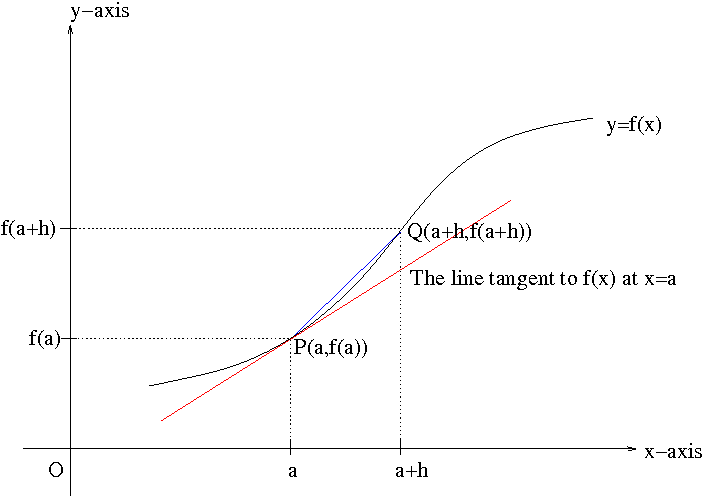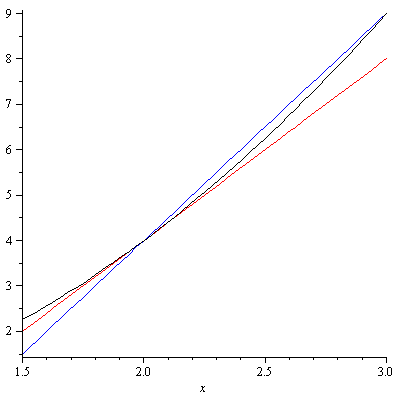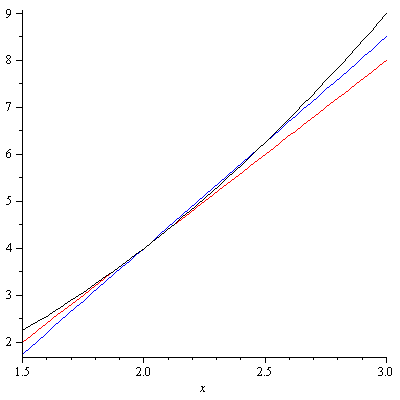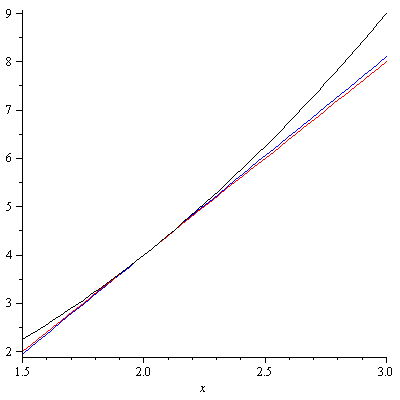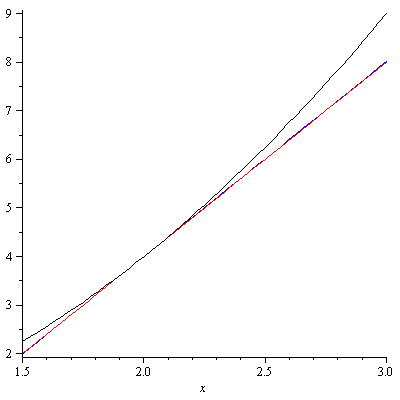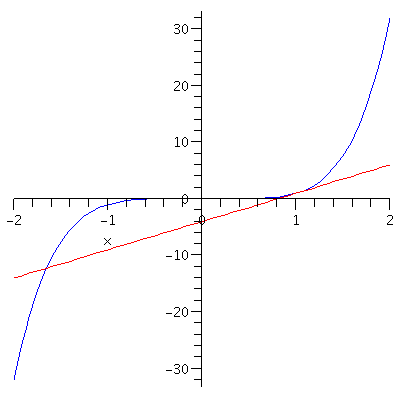Let us recall the definition of the derivative $$f'(x)=\lim_{h\to 0}\frac{f(x+h)-f(x)}{h}.$$ Replace $h$ by $\Delta x$. Then $f'(x)$ is rewritten as $$f'(x)=\lim_{\Delta x\to 0}\frac{f(x+\Delta x)-f(x)}{\Delta x}.$$ In mathematics, $\Delta$ often means an increment. So $\Delta x$ means an increment of $x$. Note that $\Delta x$ could be positive or negative. Denote by $\Delta y$ the difference $f(x+\Delta x)-f(x)$. $\Delta y$ is called an increment of $y$. Hence, the average rate of change of $y$ with respect to $x$ in the interval $[x,x+\Delta x]$ is the difference quotient $$\frac{\Delta y}{\Delta x}=\frac{f(x+\Delta x)-f(x)}{\Delta x}.$$ In the view of Gottfried Leibniz, one could think of $\Delta x$ as becoming infinitesimal. The resulting quantity is denoted by $dx$. When $\Delta x$ becomes the infinitesimal $dx$, $\Delta y$ simultaneously becomes the infinitesimal $dy$. The infinitesimals $dx$ and $dy$ are called differentials. Hence the ratio $\frac{\Delta y}{\Delta x}$ becomes $\frac{dy}{dx}$ accordingly, and it is exactly equal to $f'(x)$. The quantity $\frac{dy}{dx}$ can be viewed as the ratio of differentials or as s synonym for $f'(x)$.
Leibniz Notation: If $y=f(x)$, the derivative $f'(x)$ can be written $$\frac{dy}{dx},\frac{df(x)}{dx},\ \mbox{or}\ \frac{d}{dx}f(x).$$ This is just a notation and does not represent a division. Using Leibniz notaion, the value $f'(a)$ of $f'(x)$ at a specific point $x=a$ can be written $$\left.\frac{dy}{dx}\right|_{x=a}\ \mbox{or}\ \left.\frac{df(x)}{dx}\right|_{x=a}.$$
Calculating derivatives using the limit defintion can be really laborious. In actual practice, special rules and formulas are derived for differentiating certain types of functions. The following are such rules and they can be proved striaghtforwardly by the definition of the derivative.
Theorem 15. Let $c$ be a constant, and $f(x)$ and $g(x)$ be two differentiable functions of $x$.
- $\displaystyle\frac{dc}{dx}=0$
- $\displaystyle\frac{d(cf(x))}{dx}=c\frac{df(x)}{dx}$
- $\displaystyle\frac{d[f(x)+g(x)]}{dx}=\frac{df(x)}{dx}+\frac{dg(x)}{dx}$
The converse of the first rule is also true, namely if $f'(x)=0$ for all $x$ in the domain then $f(x)$ is a constant function. This will be proved later.
Lemma 16. [Binomial Theorem] \begin{eqnarray*}(a+b)^n&=&\begin{pmatrix}n\\0\end{pmatrix}a^nb^0+ \begin{pmatrix}n\\1\end{pmatrix}a^{n-1}b+\begin{pmatrix}n\\2\end{pmatrix}a^{n-2}b^2+\cdots+\begin{pmatrix}n\\k\end{pmatrix}a^{n-k}b^k+\\&&\cdots+\begin{pmatrix}n\\n-1\end{pmatrix}ab^{n-1}+\begin{pmatrix}n\\n\end{pmatrix}a^0b^n\\&=&a^n+\begin{pmatrix}n\\1\end{pmatrix}a^{n-1}b+\begin{pmatrix}n\\2\end{pmatrix}a^{n-2}b^2+\cdots+\begin{pmatrix}n\\k\end{pmatrix}a^{n-k}b^k+\\&&\cdots+\begin{pmatrix}n\\n-1\end{pmatrix}ab^{n-1}+b^n,\end{eqnarray*} where $$\begin{pmatrix}n\\k\end{pmatrix}=\frac{n!}{k!(n-k)!}.$$ $\begin{pmatrix}n\\k\end{pmatrix}$ is also denoted by $n{\mathrm C}k$. The binomial coefficients $\begin{pmatrix}n\\k\end{pmatrix}$ can be also easily obtained by Pascal’s triangle. For details see here and here.
Theorem 17. [Power Rule] $\displaystyle\frac{dx^n}{dx}=nx^{n-1}$
Proof. Let $y=x^n$. Then by the Binomial Theorem \begin{eqnarray*}\frac{dx^n}{dx}&=&\lim_{\Delta x\to 0}\frac{\Delta y}{\Delta x}\\&=&\lim_{\Delta x\to 0}\frac{(x+\Delta x)^n-x^n}{\Delta x}\\&=&\lim_{\Delta x\to 0}\frac{\left[x^n+nx^{n-1}\Delta x+\frac{n(n-1)}{2!}x^{n-2}(\Delta x)^2+\cdots+(\Delta x)^n\right]-x^n}{\Delta x}\\&=&\lim_{\Delta x\to 0}\left[nx^{n-1}+\frac{n(n-1)}{2!}x^{n-2}\Delta x+\cdots+(\Delta x)^{n-1}\right]\\&=&nx^{n-1}.\end{eqnarray*}
Example. If $y=3x^5$, then by Property 2 of Theorem 15 and Power Rule (Theorem 17), we have \begin{eqnarray*}\frac{dy}{dx}&=&3\frac{dx^5}{dx}\\&=&3(5)x^{5-1}\\&=&15x^4.\end{eqnarray*}
Remark. In Theorem 17 Power Rule is established only for the case when $n$ is a positive integer. The formula is indeed valid for all real $n$’s.
Example. If $y=8x^{-\frac{3}{4}}$, then we have $$\frac{dy}{dx}=8\left(-\frac{3}{4}\right)x^{-\frac{3}{4}-1}=-6x^{-\frac{7}{4}}.$$
Using Theorems 15 and 17, we can now find the derivative of any polynomial function.
Example. If $y=2x^4-x^3-2x+7$, then \begin{eqnarray*}\frac{dy}{dx}&=&\frac{d(2x^4)}{dx}-\frac{d(x^3)}{dx}-2\frac{dx}{dx}+\frac{d(7)}{dx}\\&=&8x^3-3x^2-2.\end{eqnarray*}
Example. The function $f(x)=\displaystyle\frac{3x^3-4}{x^2}$ does not appear to be a power function, but it actually can be written as a power function. $$f(x)=\frac{3x^3-4}{x^2}=\frac{3x^3}{x^2}-\frac{4}{x^2}=3x-4x^{-2}.$$ Hence we have $$f'(x)=\frac{d(3x)}{dx}-\frac{d(4x^{-2})}{dx}=3+8x^{-3}.$$
Example. The function $y=\root 3\of{x^2}-3\root 3\of{x}-5$ can be also written as a power function. \begin{eqnarray*}y&=&\root 3\of{x^2}-3\root 3\of{x}-5\\&=&(x^2)^{\frac{1}{3}}-3x^{\frac{1}{3}}-5\\&=&x^{\frac{2}{3}}-3x^{\frac{1}{3}}-5.\end{eqnarray*} Hence, $$\frac{dy}{dx}=\frac{2}{3}x^{-\frac{1}{3}}-x^{-\frac{2}{3}}.$$



